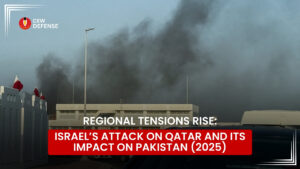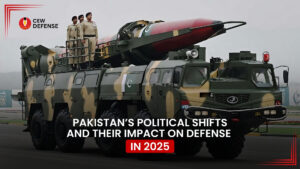India and Pakistan share a long history of conflict and rivalry, making their military strength a key issue for South Asian security. Both countries have large armies and nuclear weapons, which makes their relationship very tense.
As per reports, in 2025, India has the world’s second-largest defense budget and is rapidly modernizing its forces with new technology and weapons. Pakistan, though smaller in size and budget, uses smart strategies and strong partnerships to stay prepared.
This article provides an India vs Pakistan military comparison 2025, looking at their armies, air forces, navies, budgets, and nuclear weapons. Understanding these factors helps explain the balance of power between the two countries and the impact on the region’s peace and security.
At a Glance: Key Military Statistics (2025)
Category | India | Pakistan |
Population | 1.4 Billion | 241 Million |
Defense Budget | $83.7 Billion (2023–24) | $10.3 Billion (2023–24) |
Active Personnel | 1.45 Million | 654,000 |
Reserve Personnel | 1.15 Million | 550,000 |
These headline figures are supported by the latest defense budget reports and open-source military strength indexes (Global Firepower).
Manpower and Military Personnel
India maintains one of the world’s largest standing armies, supported by substantial reserve forces and paramilitary units. Its military recruitment spans diverse regions and skill sets, contributing to its large personnel pool.
Pakistan’s armed forces, while comparatively smaller in size, are recognized for specialized training, high operational readiness, and rapid deployment capabilities, particularly along its western and eastern borders.
Air Power: Strike and Surveillance Capabilities
Category | India | Pakistan |
Total Aircraft | 2,296 | 1,434 |
Fighter Jets | 595 (Rafale, Su-30MKI, Tejas) | 390 (JF-17, F-16, Mirage III/V) |
Attack Helicopters | 37 (Apache, HAL Rudra) | 55 (AH-1 Cobra) |
Transport Aircraft | 250+ | 100+ |
Airborne Early Warning Systems (AEW&C) | 8+ (Netra, Phalcon) | 3+ (ZDK-03, Erieye) |
According to Cosmos Connect Analysis, India’s Air Force prioritizes multi-role capability and strategic reach, featuring a mix of indigenous aircraft and global partnerships. Pakistan’s Air Force, while numerically smaller, integrates modern platforms like the JF-17 Thunder and F-16s, supported by ongoing collaborations with China and Turkey, as reported by Global Firepower.
Naval Forces: Maritime Reach and Strategy
Category | India | Pakistan |
Total Naval Assets | 295 | 114 |
Aircraft Carriers | 2 (INS Vikramaditya, INS Vikrant) | 0 |
Submarines | 19 (Nuclear + Diesel-Electric) | 11 (Diesel-Electric, AIP) |
Frigates | 14 | 9 |
Destroyers | 10 | 0 |
Corvettes | 23 | 0 |
India’s Navy supports regional presence in the Indian Ocean Region (IOR) with capabilities geared toward blue-water operations as reported by Sarkari Pariksha Breakdown. Pakistan’s Navy focuses on maritime security, coastal defense, and asymmetric deterrence, particularly in the Arabian Sea.
Nuclear Deterrence: Strategic Arsenal
Category | India | Pakistan |
Nuclear Warheads | 160–170 (Estimated) | 165–175 (Estimated) |
Delivery Systems | Agni-series, Prithvi, BrahMos | Shaheen-series, Babur, Nasr |
Triad Capability | Yes (Land, Sea, Air-based) | Developing/Partial Triad |
According to Times Now News India vs Pakistan military comparison 2025, maintain credible minimum deterrence policies, with India emphasizing “No First Use” and Pakistan following “Full Spectrum Deterrence”. Strategic modernization continues in both arsenals with new missile systems and delivery platforms.
Land Power: Ground Warfare Readiness
Category | India | Pakistan |
Tanks | 4,500+ (T-90, Arjun, T-72) | 3,800+ (Al-Khalid, T-80UD) |
Armored Vehicles | 100,000+ (Including APCs & IFVs) | 25,000+ |
Artillery (Towed) | 4,000+ | 3,200+ |
Self-Propelled Guns | 100+ | 600+ |
Multiple Rocket Launchers | 300+ | 200+ |
India focuses on network-centric warfare, indigenization, and deep logistics support, while Pakistan emphasizes tactical maneuverability and cross-domain integration with regional allies.
Cyber, Space, and Intelligence
- India has established a dedicated Defence Cyber Agency (DCA) and Defence Space Agency (DSA). Satellites such as RISAT and Cartosat enhance surveillance and communication.
- Pakistan is strengthening cyber and electronic warfare capabilities through military tech partnerships and invests in asymmetric and hybrid warfare strategies.
Logistics and Strategic Mobility
Category | India | Pakistan |
Military Airports | 60+ | 25+ |
Merchant Marine Ships | 1,800+ | 60+ |
Logistics Doctrine | Based on Integrated Battle Groups | Based on Corps-Level Strike Forces |
India’s logistics are enabled by a vast network of defense-industrial bases and multinational procurement lines. Pakistan prioritizes strategic depth and regional agility, particularly along critical terrains.
Defense Budgets and Modernization
Category | India | Pakistan |
Annual Defense Budget (2023–24) | $83.7 Billion | $10.3 Billion |
Modernization Programs | Multi-billion-dollar projects | Strategic procurement from China, Turkey |
India’s budget supports major upgrades in aircraft carriers, missile systems, and indigenous platforms like Tejas Mk2. As per Geo News, Pakistan emphasizes cost-effective modernization, including JF-17 upgrades, air defense systems, and Chinese drones.
India vs Pakistan Military Comparison 2025: Key Observations and Strategic Takeaways
- India’s military scale and technological base position it as a leading regional power.
- Pakistan’s tactical proficiency, alliance-building, and focus on asymmetrical strategies allow it to maintain regional deterrence despite budgetary constraints.
- Both countries are nuclear-armed and operate under complex doctrinal postures, making stability and communication essential.
Conclusion: Balance Over Bravado
While India vs Pakistan military comparison 2025 provides insights into military capacity, real-world outcomes depend on geography, alliances, strategy, and diplomacy.
Both India and Pakistan continue to evolve as defense powers, and while competition remains, the imperative for peace, dialogue, and de-escalation grows even stronger in a nuclear-armed neighborhood.







